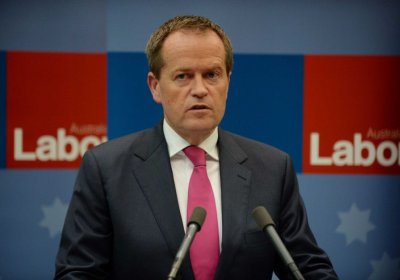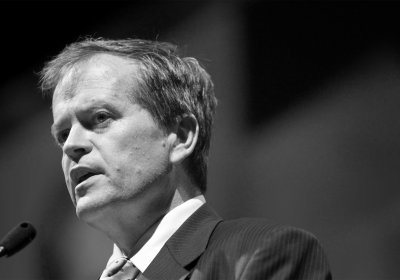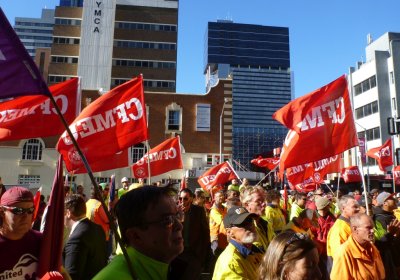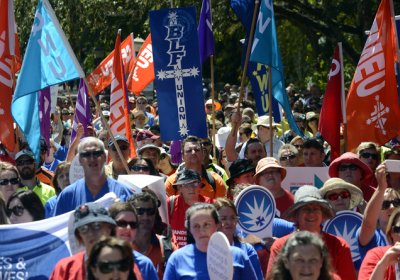The future of the federal government’s anti-union, kangaroo court — the Royal Commission into Trade Union Governance and Corruption — is in doubt, following media revelations that the commissioner, retired High Court Justice John Dyson Heydon, accepted an invitation — not once, but twice — to speak at a Liberal Party fundraiser while serving on the body. The commission first sat on April 9 last year and media reports say Heydon received the invitation to speak via email just one day later, on April 10. He was approached again in March.
Royal Commission into Trade Union Governance and Corruption
Why was John Dyson Heydon QC liberal prime minister Tony Abbott’s “captain's pick” to run the royal commission into the trade unions?
It could be from the shared solidarity that you’d expect of Rhodes scholars. Or perhaps it was just innocent association from the time former Prime Minister John Howard appointed Dyson Heydon to the High Court in 2003, a position he retired from under the compulsory age rule of 70 in 2013.
The financial scandal in the Health Services Union (HSU) involving its national president Michael Williamson and former national secretary Craig Thompson ended in the courts when both of them were convicted for fraud and theft offences.
It became the trigger for Prime Minister Tony Abbott to announce on February 10 last year that he was setting up a Royal Commission into Trade Union Governance and Corruption headed by former High Court judge Dyson Heydon.
From his late teens, Bill Shorten would tell anyone who listened that his ambition was to be Labor prime minister, following in the footsteps of his heroes Bob Hawke and Paul Keating. But first of all he had to find a faction because, in the Labor Party, it is the factions who have the power to select MPs, premiers and prime ministers.
Opposition leader Bill Shorten’s persistent response to media questions about allegations raised in the unions’ Royal Commission concerning his former union, the Australian Workers Union (AWU), has been to refuse to provide a “running commentary”.
After being requested by the commission to appear before it last week, he is now reported as saying: “I welcome the opportunity to talk about my 21-year record of standing up for workers”.
On May 19, the federal government’s Royal Commission into Trade Union Governance and Corruption released a 116-page discussion paper recommending a swathe of new attacks on union rights.
The proposals give the clearest indication so far of the likely outcome of the expensive inquisition into the union movement when the commission releases its findings in December.
The document presents little more than a sweeping wish list of restrictions on the rights of union officials and the ability of unions to carry out their work to benefit members.
Releasing the interim report of the Royal Commission into Trade Union Governance and Corruption on December 19, employment minister Eric Abetz said the findings showed the decision to hold a royal commission into unions had been “vindicated”.
However, the fact that almost every substantial case examined by the royal commission was already making its way through the legal system, suggests the system is working. A royal commission is a tool government can effectively employ when there is a serious failure by the existing regulatory system.
The Royal Commission into Trade Union Governance and Corruption, appointed by the Abbott government and headed by retired judge Dyson Heydon, released its interim report on December 19. The report called for criminal charges to be laid against several Construction, Forestry, Mining and Energy Union (CFMEU) officials, including charges of blackmail against the CFMEU's Victorian state secretary John Setka and assistant secretary Shaun Reardon.
The witch-hunt into unions descended into farce last month as the Royal Commission’s attempt to justify its existence instead showed that it is an inquiry compromised by its politically motivated construction and damned by its own incompetence.
The week began with Australian Council of Trade Unions (ACTU) assistant secretary Tim Lyons attacking royal commissioner Dyson Heydon and senior counsel assisting Jeremy Stoljar for confusing workplace bargaining with corruption and failing to understand the role of unions they had been asked to investigate.
When the Royal Commission into Trade Union Governance and Corruption was set up by the federal government, it was widely seen as a political witch hunt intended to smear the union movement with guilt by association to the scandals that had emerged in the Health Services Union (HSU).
With a bit of good fortune and a lot of spin-doctoring it would also provide the Coalition with handy ammunition against the ALP at the next federal election, likely to be held in late 2016 — a contrived “ticking Tampa”.
The serious financial fraud that surfaced in the scandal-ridden Health Services Union (HSU) provided the federal government with a handy excuse to establish the Royal Commission into Trade Union Governance and Corruption.
Although the commission has powers wide enough to inquire into all unions, the HSU is one of five organisations specifically mentioned in its terms of reference alongside the Australian Workers Union, Communications Electrical Plumbing Union, Construction Forestry Mining Energy Union, and the Transport Workers Union.
The revolution might not be televised, but you can see the Royal Commission into Trade Union Governance and Corruption proceedings live-streamed into your lounge room.
Such is the overwhelming public demand for riveting daytime televised reality shows that the commission is competing with Judge Judy in bringing this much-awaited courtroom drama to a computer near you via a mere click on their website.
The proceedings began in earnest on June 10, but much of what was heard in evidence has been well rehearsed in the Murdoch press over the past couple of years.
- Previous page
- Page 2
- Next page










